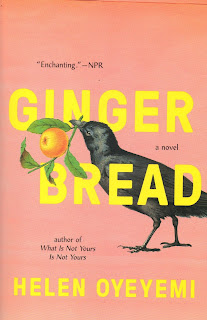What a twist: Gingerbread’s romance trope subversions
(Spoilers ahead, obviously!)
I wrote a review for Helen Oyeyemi’s ‘Gingerbread’ last year, but there were two parts of it I couldn’t talk about because they were spoilers – the kind of twists that are most refreshing if experienced unexpectedly, especially if you are tired of common romance tropes. But I also really want to gush about them a bit. So that’s what this is.
#1. Not-a-love-triangle: When we are introduced to cousins Gabriel and Rémy Kercheval, a reader can be forgiven for expecting a classic YA-style love triangle or agreeing with the guess by one of the talking dolls that “sexy bad boy” Rémy will turn out to be the father of Perdita (Harriet’s daughter). This thought lingers because Harriet is our POV and, while she has always had a stronger crush on Rémy, she thinks:
Wouldn’t chasing Rémy be like running after a tiny kitten that turned around, morphed into a cheetah, and hunted you down…?
But no! Her first impressions of these two are entirely wrong and it never becomes a love triangle.
Though he loves to badmouth his family and screw with people, Rémy is the most consistently helpful member of the Kercheval clan; Creating a fake resumé for Harriet’s mother Margot so she can get a job is a good early indication of both qualities. A little later, Harriet figures out that Rémy’s disconcerting way of watching someone’s mouth when they talk isn’t scornful or lustful but simply due to him being hard of hearing. When “good boy” Gabriel gets Harriet pregnant and starts acting scary when she keeps missing appointments at the abortion clinic, she texts Rémy and he comes instantly: “What’s all this about wanting me to ask Gabriel where your body is if you go missing?” His way of shielding her – by claiming to be the father - also pisses off the rest of the family. So it’s a win-win, in his book! He thinks she’s making a mistake by keeping the baby but doesn’t try to pressure her. Years later, when Perdita goes looking for Harriet's friend/crush Gretel (more on that in a minute), Rémy tries to steer her away from the minefield of the Kercheval family by taking on a disguise that she calls the “gentleman detective”. It doesn’t work…but it is a very Rémy plan!
Harriet probably should have taken a hint that Rémy wasn’t going to be romantically interested in her from their school days. He liked to sit and read in a corner of the common room with a shawl thrown over his legs:
Other boys occasionally commented on the gheyness of this pastime…and Rémy would either say Yup yup and go back to his book, or he’d cast his blanket aside and begin a heterosexuality-threatening game of kiss chase, which he so rarely lost that by the time his schooldays came to an end, the only boys who continued to use ghey as a derogatory term in his earshot were the ones who wanted to see if he was up for a snog and had never learned how to ask nicely.
Also, while Harriet’s own experience might lead her to not rule anything out on that score…it’s not like Rémy’s “bad boy” reputation actually includes being a ladies’ man.
By the end, Rémy is happily settled with a boyfriend and a pet tortoise. We don’t actually get to meet them – which is a tragedy, in my opinion. I want more Rémy in this story! Since he somewhat fits my favorite ‘Drama Goth’ archetype (as with Vikram in ‘Alif the Unseen’ he pretends to be bad - or at least edgy - but his actions are unfailingly nice), I like to imagine that the boyfriend is a fussy bookshop owner who dresses like he raided a historical clothing shop.
#2. Supernatural creature behaves responsibly: Harriet’s girlhood friend Gretel – another Kercheval, supposedly – is very likely not human. She has double pupils in her eyes and declares herself to be a Changeling. She says her job is to “assist people who’ve changed their minds in a way that means their lives have to be different too.” We also get a lot of clues in this story that Gretel is more than a friend (at least in Harriet’s mind): they win matching rings and Harriet wears hers in the engagement ring position, she imagines their reunion including Gretel sucking a piece of shortbread out of her mouth with a kiss, etc. Given all this, we might expect a supernatural romance conclusion. It’s certainly what Harriet seems to be expecting, when she realizes that three houses she’s supposed to check out are in the locations where she and Gretel once proposed to meet up when Harriet was grown.
But that’s not what happens – and probably a good thing, too. Gretel once noted that “growing up isn’t in my job description”; it would be a bit weird if Harriet is 35 and Gretel still looks 16! Instead, Harriet runs into a beautiful baker named Salomea, “a native speaker of a Romance language…there was romance with a lowercase ‘r’ too, this woman would nip Harriet’s lower lip just before they kissed for the first time. And Harriet would like it. Really, really, and a lot.” Harriet, of course, is a baker too – of the titular gingerbread – and you can tell by the unusual aesthetic of Salomea’s shop (eg. jam in test tubes) that she is going to fit into Harriet’s almost-witchy family just right.
Gretel does plan to turn up again, someday, at a gingerbread house that can only be unlocked by two rings:
“When you have nothing left, we’ll meet at that house and pass through it. You can hardly hear me right now, and that’s good. Better listen to Salomea repeating that you’ve got to watch out with instinctual biters because they just take one bite and leave the rest…with the slightly anxious bravado of someone who is no longer sure that theory is going to hold up to practice this time…So for now I’ll just say that I, your scribe, your friend, hope I’ve also managed to be a friend to all your other friends. Let’s talk when we get to the house, the that third unhaunted house. See you there. (Just as I’ve seen you here).”
Gah, my heart!


